Sweet wormwood is the modern world's answer to malaria and the increasing number of antibiotic-resistant strains. Also known as "sweet annie plant" in North America, and "qing hao" in TCM, this medicinal herb is native to grassland and open areas in Vietnam, Japan, China, Russia, and North America, and has been widely naturalized in other parts of the world.
Sweet Wormwood Medicinal Properties
Health Benefits of Sweet Wormwood
The antiparasitic and antibiotic properties of sweet wormwood have found the following medicinal uses:
Treating malaria and dengue fever. Sweet wormwood has been shown to be highly effective in treating malaria as well as dengue fever.
Relieving headaches and fever. The sweet wormwood leaves' extract has been traditionally used as an anti-inflammatory, antipyretic agent.
How It Works
The most important compound in sweet wormwood leaves is a an antimalarial sesquiterpene called artemisinin, which works by disrupting the sexual reproduction of the most deadly malarial parasite, Plasmodium falciparum, eventually killing it off completely.1
Besides antimalarial activity, sweet wormwood has antioxidant, antibacterial, antifungal, and anti-inflammatory biological activities, due to the presence of secondary metabolites, such as flavonoids, steroids, aromatic ketones, aromatic acids, alkaloids, and coumarins, among others.2 These compounds not only contribute to relieve fever and headaches, but are also are known to interfere directly or indirectly with various inflammatory mediators, including nitric oxide (NO), which plays a central role in inflammatory and immune reactions involved in neurodegenerative disorders, such as Alzheimer's disease.3
Artimesinin works by disrupting the sexual reproduction Plasmodium falciparum, a protozoan parasite that causes malaria.
Herbs that also help reduce fever and inflammatory pain are aspen, feverfew, lemon verbena, and marigold. Additionally, antimalarial properties can be found in achiote and neem.
Sweet Wormwood Side Effects
Although sweet wormwood is generally free of side effects, it should be taken under the supervision of a doctor, who will be able to monitor the state of the malaria infection.
Sweet Wormwood Cautions
Pregnant women should not take sweet wormwood except with a doctor's guidance. This herb should not be taken over a long period of time due to potential toxicity, but for the treatment of malaria, only short-term use is necessary.
- Medicinal action Antipyretic, Antimalarial
- Key constituents Artemisinin, secondary metabolites (such as flavonoids, steroids,, aromatic ketones, aromatic acids, alkaloids, and coumarins)
- Ways to use Capsules, Hot infusions/tisanes, Tincture, Dried
- Medicinal rating (4) Very useful plant
- Safety ranking Use with caution

How to Consume Sweet Wormwood
Natural Forms
Dried. The dried leaves of sweet wormwood can be used to prepare herbal remedies at home.
Infusion. The dried leaves of sweet wormwood are traditionally steeped in hot water, and the warm infusion is taken for soothing headaches and reduce fever.
Herbal Remedies & Supplements
Tincture. This is a concentrated form with a long shelf-life, obtained from the maceration of sweet wormwood with alcohol. few drops need to be diluted water to reap the medicinal properties of the herb.
Capsules. Supplements are the most commonly used form of wormwood in the treatment in malaria because they are standardized. Because malaria is a serious illness, wormwood supplements should be taken under the care of a physician.
Sweet wormwood is usually processed pharmaceutically into concentrated malaria medications - such as artemether - as the plants only contain about 1% artemisinin.
- Taste Bitter, Pungent

Growing
In countries with temperate to subtropical climates, sweet wormwood cultivation is quite easy.
Growing Guidelines
Sweet wormwood can be propagated from seed and must be planted in the spring, as it needs full sun in order to survive, but can also be propagated by dividing the root stock in autumn.
Sweet wormwood planting should involve sowing the seeds about 18 inches (45 cm) apart and lightly pressing the seeds onto the top layer of soil, as they need light in order to germinate.
Once the sweet wormwood plants have started growing, they only need occasional watering, and being pruned now and then in order to prevent them from becoming too unruly.
- Life cycle Annual
- Harvested parts Leaves
- Light requirements Full sun
- Growing habitat Temperate climates, Subtropical regions
- Planting time Spring
- Plant spacing average 0.5 m (1.64 ft)
Additional Information
Plant Biology
Sweet wormwood plants can grow up to 6.5 feet (2 m) high and bear bright green, saw-toothed leaves. The sweet wormwood flower heads are minute and cream-colored.
Classification
Sweet wormwood (Artemisia annua) is a member of the Asteraceae or sunflower family, which comprises about 30,000 species across 2,000 genera. Other medicinal herbs within this large family are chamomile (Matricaria chamomilla), chicory (Cichorium intybus), dandelion (Taraxacum officinale), and marigold (Tagetes erecta); while artichoke (Cynara cardunculus), lettuce (Lactuca Sativa), and sunflower (Helianthus annuus) are among the most economically important ones.
Related Species
There are over 100 Artemisia species, some of which are used in food and drink products. Close relatives of sweet wormwood (A. annua) include tarragon (A. dracunculus) and absinthe (A. absinthium). The species A. apiacea can be used interchangeably with for medicinal purposes.
Historical Information
The history of sweet wormwood seems to stretch back to 168 BCE, when it was mentioned in a text proclaiming that it "helped clear and relieve summer heat." It is a traditional Chinese medicine, having been used for more than 2,000 years to alleviate fevers. However, more recently, attention has shifted to its well-researched antimalarial properties. Scientific studies into this use of sweet wormwood began in the 1970s, as strains of malaria that were resistant to conventional medications of the time started appearing.
Economic Data
The sweet wormwood market is a booming business, and it is cultivated on a commercial scale in China, its largest producer. Many pharmaceutical companies convert artimesinin into the medicines artemether and artemotil, so sweet wormwood trading is becoming more and more profitable.
Other Uses
Cosmetics. Sweet wormwood has few uses other than its medicinal value, although the aromatic essential oil is sometimes used in cosmetic products and perfumes.
The medicinal power of sweet wormwood has been known for millennia, although its use as a malarial treatment is relatively new.
- Other uses Cosmetics, Perfume
Sources
- Critical Reviews in Toxicology, Toxicity of the antimalarial artemisinin and its dervatives, 2010
- PLOS ONE, Dried whole plant Artemisia annua as an antimalarial therapy, 2012
- The American Journal of Tropical Medicine and Hygiene, Adverse effects in patients with acute falciparum malaria treated with artemisinin derivatives, 1999
- USDA Plants Database, Classification for Kingdom Plantae Down to Genus Artemisia L
- Encyclopedia of Herbal Medicine, pp. 66-7
- Medicinal Plants of the World, pp. 55-6
- Kew Royal Botanic Gardens, Artemisa annua (sweet wormwood)
- Food and Chemical Toxicology, Toxic essential oils. Part II: chemical, toxicological, pharmacological and microbiological profiles of Artemisia annua L. volatiles, 2013
- International Journal of Antimicrobial Agents, Antimicrobial activity of flavonoids, 2005
Footnotes:
- Phytotherapy Research. (2018). Combination of artemisinin-based natural compounds from Artemisia annua L. for the treatment of malaria: Pharmacodynamic and pharmacokinetic studies. Retrieved November 7, 2023, from: https://pubmed.ncbi.nlm.nih.gov/29656410/
- Molecules. (2010). Flavonoids from Artemisia annua L. as antioxidants and their potential synergism with artemisinin against malaria and cancer. Retrieved November 7, 2023, from: https://pubmed.ncbi.nlm.nih.gov/20657468/
- Aging and Disease. (2020). Artemisinin Improved Neuronal Functions in Alzheimer's Disease Animal Model 3xtg Mice and Neuronal Cells via Stimulating the ERK/CREB Signaling Pathway. Retrieved November 7, 2023, from: https://pubmed.ncbi.nlm.nih.gov/32765947/






